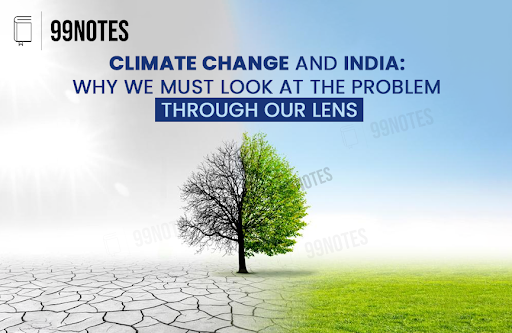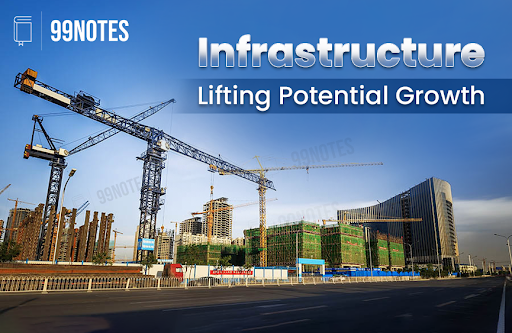Ch-13 CLIMATE CHANGE AND INDIA: WHY WE MUST LOOK AT THE PROBLEM THROUGH OUR LENS
- As the world’s most populous country, currently globally the 5th largest economy, India is headed to become the 3rd largest by 2030, this means that our energy needs are expected to grow about 1.5 times faster than the global average in the next 30 years.
India’s achievements against targets for climate change:
- Reduced emission intensity of GDP by 33% from 2005 to 2019, achieving the 2030 NDC target 11 years ahead of schedule.
- Between 2017 and 2023, India has added around 100 GW of installed electric capacity, of which around 80% is attributed to non-fossil fuel based resources.
- India’s contribution to climate action is significant through its international efforts – International Solar Alliance (ISA), Coalition for Disaster Resilient Infrastructure (CDRI), creation of Lead IT, Infrastructure for Resilient Island States (IRIS), and Big Cat Alliance.
- 196 countries must meet their individual commitments under ‘Nationally Determined Contributions’ towards reducing carbon emissions to limit the global temperature increase to 1.5 degrees Celsius above pre-industrial levels.
CLIMATE CHANGE AND THE GLOBAL APPROACH
- Greenhouse gas (GHG) emissions, particularly carbon dioxide (CO2), primarily contribute to adverse climate change.
- The Intergovernmental Panel on Climate Change (IPCC) paints a dire picture – emissions pose a serious threat since CO2, once released into the atmosphere, can hang for 300 to 1000 years causing global warming and environmental destruction.
- The world has adopted a strategy that comprises a set of pathways, popularly called ‘climate adaptation’ and ‘climate mitigation.
WEO-2023 proposes a global strategy for getting the world on track by 2030
The Five Key Pillars to this proposal include
- Tripling global Renewable Energy Capacity
- Doubling the rate of Energy Efficiency improvements.
- Slashing methane emissions from fossil fuel operations by 75 per cent.
- Innovative, large-scale financing mechanisms to triple clean energy investments in emerging and developing economies.
UNDERSTANDING OF LAWS OF LIFE
Two simple principles that stand paramount about laws of life :
1) Humans cannot create a new element, cannot change any law of nature, and cannot synthesise a process that doesn’t take or release to the environment.
2) Fundamentals of existence remain the same eternally.
Globally, Power and Transport industries have the maximum contribution to GHG emissions, followed by Industrial combustion, Agriculture, and Waste industries. Of the latter, Beef production has the highest emissions per kilogram of food product as seen in Tab XIII.1.
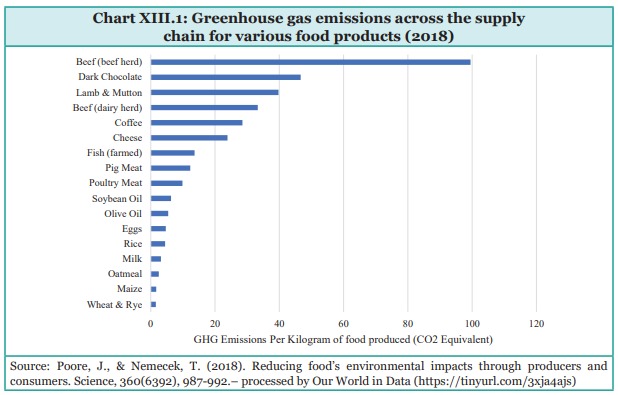
- The entire developed world uses toilet paper made of ‘virgin wood’ for the most regular body activity, every single day, multiple times over. One of the best global sustainability blogs ‘Tree Hugger’ states that “Making one single roll of toilet paper uses 1.5 pounds of wood, 37 gallons of water and 1.3 kWh of electricity”.
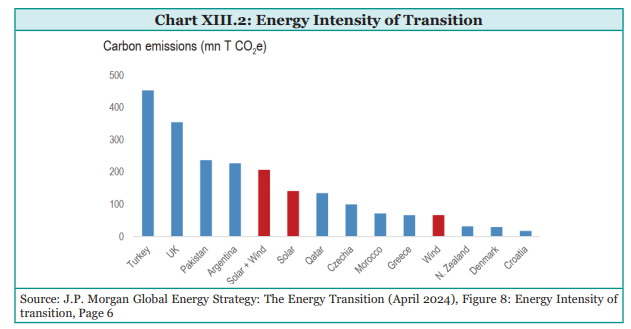
Solar panel batteries rely on mined materials like Lithium, Cobalt, Nickel, and rare earth minerals, causing environmental scars and emitting CO2 during processing, often using fossil fuels for high-temperature requirements.Top of Form
- Bottom of Form
(ChartXIII.2)
- Cobalt and Copper, used extensively in Li-ion batteries, electric vehicles, and mobile phones, have a raging sustainability crisis at the heart of their extraction.
- About 80% of the country’s cobalt production is controlled by Chinese companies who refine in China, and subsequently sell to battery manufacturers globally
- Industrialisation and development require power and energy 24/7. Even factoring in four hours of storage makes solar and wind go from the cheapest power available to much more expensive than gas and coal power (Chart XIII.3)
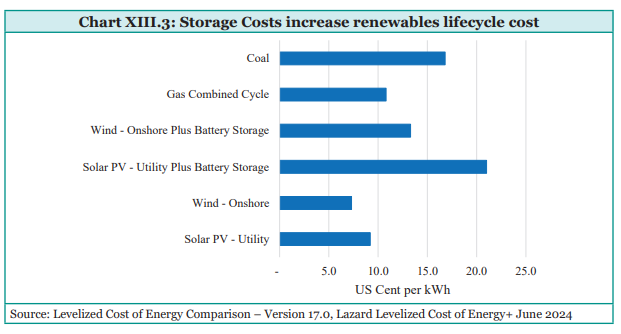
- Energy and power are often used interchangeably, However, their difference is another factor that makes climate change strategy a difficult one to follow. Matthew L Wald, an independent energy analyst, says in ‘The Myth of Solar Power’.
- The current Climate Change strategy seems to say that given that our energy needs will continue to rise, we must try replacing conventional fuel with renewables and clean energy, thus making it a substitution issue rather than a global lifestyle issue.
Global pursuit of energy-guzzling technologies
The developed world is in a mad ‘Scramble for Africa’ kind of rush to usher in the latest and the most expansive AI (Artificial Intelligence) ecosystem. Even as the data centres are ramping up energy demand, cloud storage facilities, crypto mining, and AI are all expected to increase this exponentially (Chart XIII.4).
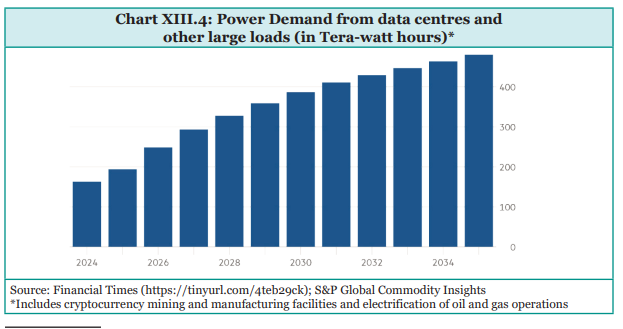
- The incompatibility of the two major movements of AI and Green energy being pushed by the West is not unseen by the global world. It seems like little thought has been put into the inevitable discordance in the chosen economic and sustainable strategies.
On the contrary, India’s historical cumulative emissions and per capita emissions are very low despite being home to more than 17% of the global population – contributing only about 4% of the global cumulative greenhouse gas emissions between 1850 and 2019 (Chart XIII.5).
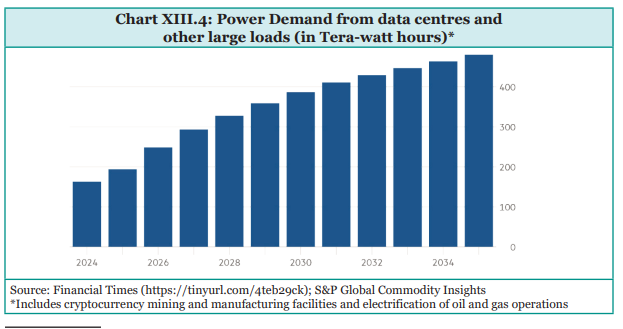
Energy Consumption (at time T) = Energy consumed by 1 person (E1) * Number of people (N) + Energy consumed by common activities required for N (EN)
Comparatively, India’s per capita emissions have consistently remained low between 2.5 and 2.8 Tons CO2eq/ year, despite substantial economic growth over the last decade. Per capita emissions of EU27 nations (8 Tons CO2eq/ year) were almost 3 times that of India.
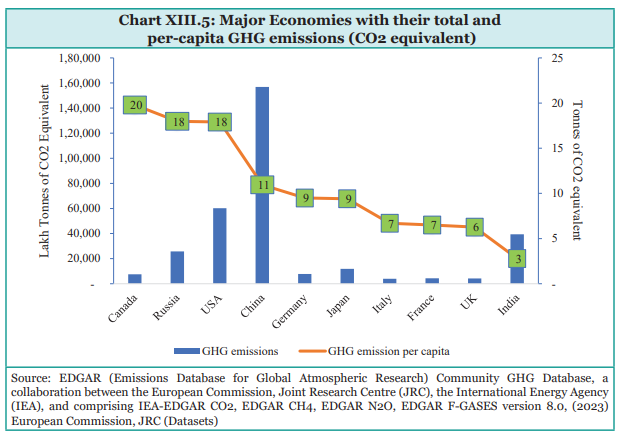
Willingness to Change and Willingness to pay for Environmentally Sustainable Policies
- 63% of OECD survey respondents feel sustainable choices should not cost more.
- Unwillingness to pay extra suggests reluctance to change consumption-oriented lifestyle.
- EU plans CBAM tax on products like steel from developing countries to price carbon emissions
- Implies developed nations imposing costs while resisting financial impacts domestically
- 43% of respondents regularly consume red meat despite its significant climate impact.
- Consumer behaviour shows disconnect between environmental concern and dietary choices.
- Market economics must not follow a universally-designed golden mean and must adapt to local conditions, is a point brought out well on several international platforms such as the 2005 and ensuing G20 declarations, the 2010-13 UN agreement that explicitly discarded One-Size-Fits-All (OSFA) and the 2015 Millennium Development Goals (Chart XIII.7).
- India must be cautious in changing both lifestyle and user behaviour learning from societies different from ours, lest it impacts us in the future on 3Es – Equity, Environment, and Economics.
- Market discipline exists in theory as seen in numerous financial market busts. The market mechanism is pro-cyclical.
The Meat Production Process and the Destruction of the food-feed balance
- As societies moved towards affluence, the quantity of meat demanded also rose. North America and Europe saw their meat production grow by 2.5 times and 1.7 times, respectively, between 1961 and 2000.
- More important is the fact that increased production in these regions was facilitated by the emergence of the modern mass-scale feed industry, which now presents a credible and significant threat to food security around the globe.
- A recent analysis published in ‘Nature’ highlighted that only 37 per cent of the harvested area of major crops is used for direct food consumption,45 while a large share of the human edible crops is now facing competing uses, primarily from the livestock industry.
- For example, the United States, with its abundance of cropland, was once thought of as the “food basket”, but today, with the rampant appropriation of arable land for feed crops, it is more likely to be termed the “feed basket”.

- By 2030, many developing countries will not be able to fulfil the calories required for nourishment of the growing population due to the deficit in calories harvested as direct food crops.
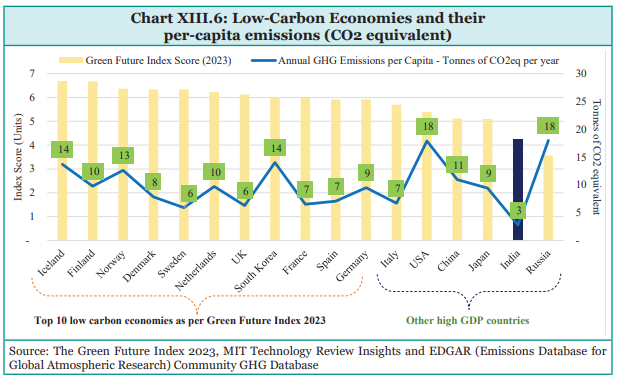
MISSION LIFE (LIFESTYLE FOR ENVIRONMENT)
- Mission LiFE70, announced by Prime Minister Modi, at the 2021 UN Climate Change Conference (UNFCC COP2026) which seeks to bring individual responsibility to the forefront of the global climate narrative.
- LiFE should have a doctrine for the world, resting on 5 fundamental principles.
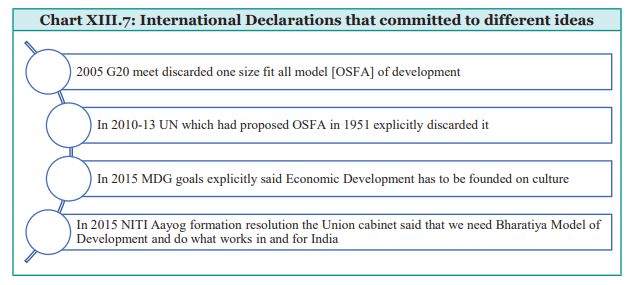
Collective policy reflective of Individual pro-planet choices
- Consistency. Compounding. Two words when practised can make and break empires. Small but consistent actions have a large compounding effect observable across time.
- These are reflected in several actions as follows:
- Using air-conditioning and thermostats at more optimum and sustainable temperatures
- Reducing the need to carry disposable plastic bags repeatedly on errands.
- Building a culture of water reuse through individual behaviour change.
- Practicing sustainable agriculture through the use of local seeds and natural farming practices.
- ) Fiscal Incentives for large households rather than single or two-person households, indirectly nudge societies to favour sustainable choices.
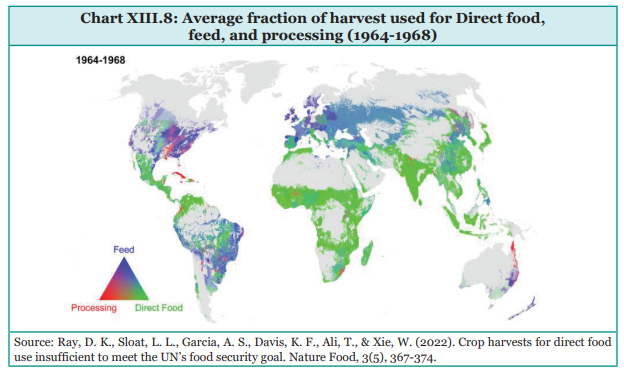
Public Policy and not the Market at the helm of undertaking the ‘right’ decision
- Policies shape individual behaviours and consumption choices through norms, incentives, and infrastructure.
- Promoted energy-efficient LED lights, resulting in significant energy savings (48 billion kWh per year) and cost savings (USD 2.5 billion per year) through Ujala Program (2015)
- Actions recommended by the International Energy Agency could reduce global CO2 emissions by LiFE INITIATIVE.
CONCLUSION
- Most important human factor often overlooked in modern life is Thairav. (settlement/ contentment) which represents equanimity and internal stability amidst internal change.
- Modern culture lacks contentment leading to excessive consumption which causes shift from communal to individual ownership.
- Emphasizes the need to address consumption habits rather than focusing solely on renewable energy.
- The global movement on climate change must be accommodative of sovereign choices and economic needs, but centred on individual behaviour -LiFE.

